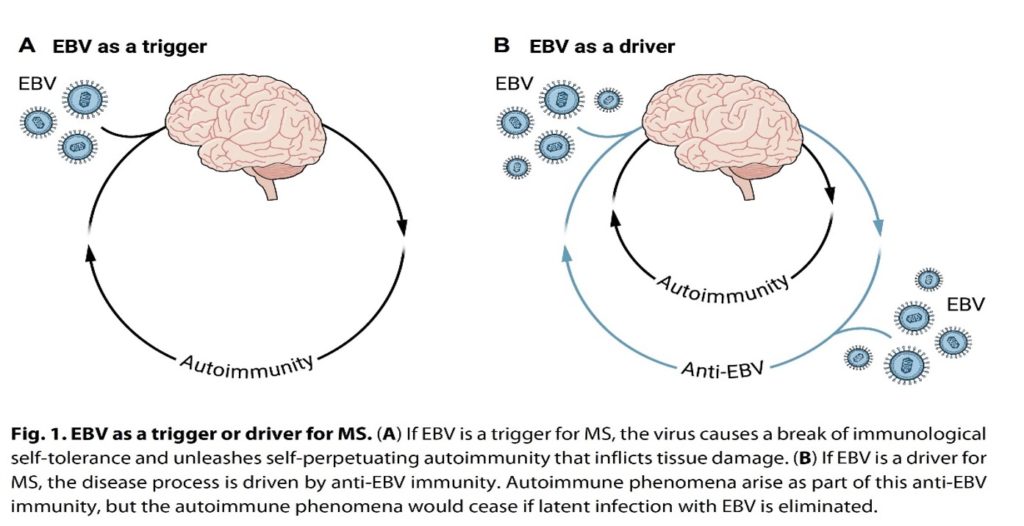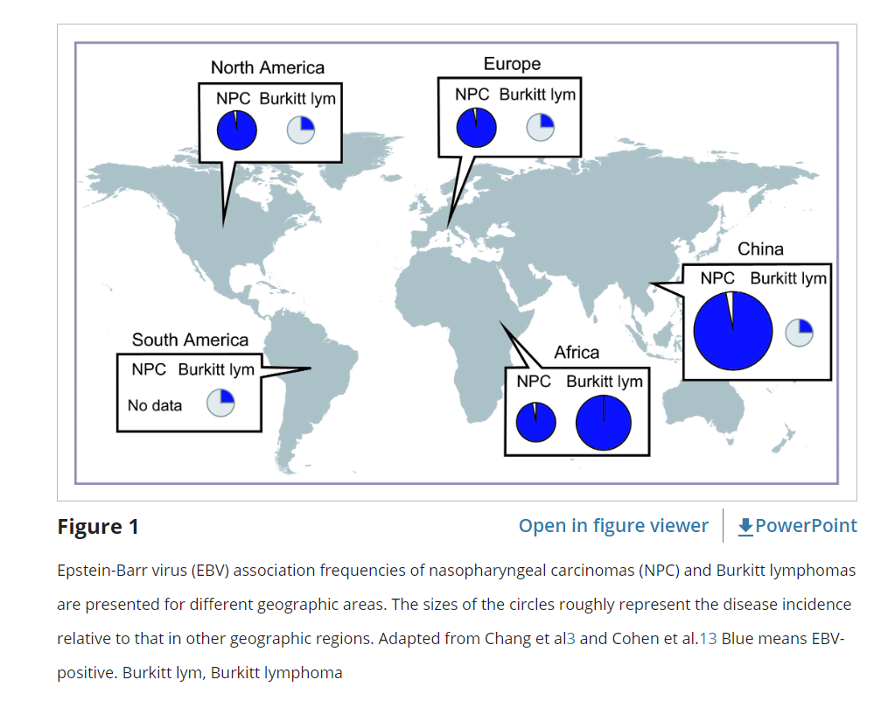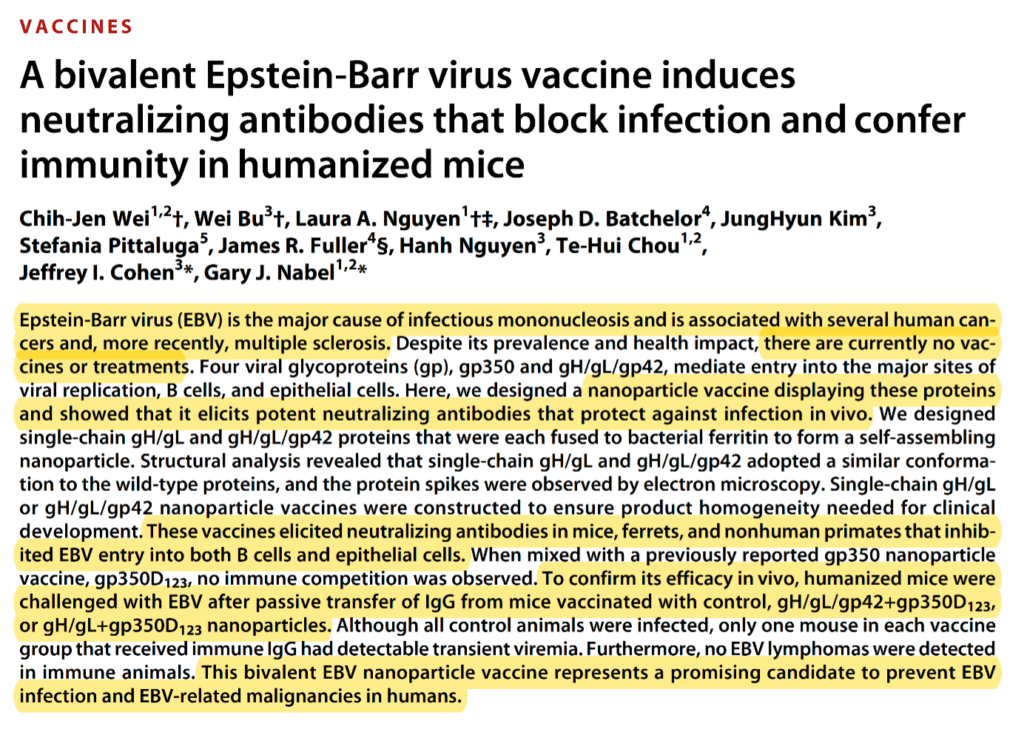In one of the most important discoveries in medicine this year, Epstein-Barr virus (EBV) has been collared as the link/early causal role in multiple sclerosis. Finding the virus underpinning multiple sclerosis (MS) in some people was a major breakthrough, as a multiplicity of causative agents had previously been marched hopefully forward, ranging from obesity to vitamin D (the Go-To for all diseases of an unknown aetiology). Even more promising, EBV may not just be a trigger, but may be a driver, such that its elimination could be a therapy for MS:

Epstein-Barr, also known as human herpesvirus 4 (or more commonly glandular fever or the Kissing Disease – so it’s not all bad), is a member of the herpes virus family. It is one of the most common human viruses, that affects all ages, and may be found evenly distributed all over the world; although outcomes, mainly neoplastic diseases (cancers), do vary by region – most likely due to strain variation.
Most people get infected with EBV at some point in their lives as it spreads most commonly through bodily fluids, primarily saliva. EBV can cause infectious mononucleosis, also called mono, and other illnesses. One diagnostic criterion for infectious mononucleosis is the presence of 50% lymphocytes with at least 10% atypical lymphocytes (large, irregular nuclei), while the person also has fever, pharyngitis, and swollen lymph nodes. The atypical lymphocytes resembled monocytes when they were first discovered, thus the term "mononucleosis" was coined. However, as usual, it’s more complicated than that and approximately 5% to 7% of cases of infectious mononucleosis are caused by human cytomegalovirus (CMV), another type of herpes virus.
Symptoms of EBV infection can include: fatigue, fever, inflamed throat, swollen lymph nodes in the neck, enlarged spleen, swollen liver and a rash. A classic mononucleosis may lead to mild immunosuppression and thus some relatively uncommon concomitant infections such as oropharyngeal candidiasis or a more general pharyngitis. Basically, a systemic illness but with a shockingly sore throat.
The story of EBV and its role in cancer began with the work of a surgeon called Denis Burkitt. During World War II he was posted to Africa, and subsequently settled in Uganda for a few years to practise medicine there.
In 1958 Burkitt first reported a specific type of cancer that was common in young children living across central Africa. These aggressive tumours – later named after him as Burkitt’s lymphoma – were caused by white blood cells multiplying out of control. The children were often brought to hospital with dental problems or swellings of the face and neck. The tumours grew rapidly and, sadly, did not respond to any treatments available at that time. Thanks in part to funding from the British Empire Cancer Campaign – a predecessor of Cancer Research UK – Burkitt was able to continue his research and study which children developed this new type of cancer in more precise detail.

On March 22, 1961, Burkitt visited England and gave a lecture at a London medical school detailing his findings for other doctors and scientists. Sitting listening to his lecture, titled “The Commonest Children’s Cancer in Tropical Africa — A Hitherto Unrecognised Syndrome”, was a young Cancer Research UK doctor called Anthony Epstein. Epstein had a particular interest in understanding disease using tests carried out in the lab, and he was an expert on using a new and very powerful tool – the electron microscope. He had also been working on the Rous sarcoma virus that caused tumours in chickens, and understood how viruses could drive the development of cancer in some circumstances. He was determined to be the first to find a cancer-causing virus in humans, and was greatly excited by Burkitt’s theory that the new type of lymphoma might be linked to a virus.
Following the lecture, the pair talked over tea and arranged samples of tumours taken from children with Burkitt’s lymphoma to be shipped from Uganda to Epstein’s lab in London. After a few long and frustrating years trying in vain to find a virus in the samples, Epstein made a breakthrough – thanks to poor weather conditions. Fog caused one of his samples to be diverted to another airport, and because of the longer journey some of the cells from the tumour shook free. Alongside a young researcher who joined his lab, called Yvonne Barr, they finally managed to grow these free-floating cancer cells to study and with the help of a colleague called Burt Achong, the “Eureka” moment finally came when they looked at the Burkitt’s lymphoma cells down the powerful electron microscope and saw some were filled with tiny virus particles. Henles and the team carried out further experiments. They found that infected cells – a type of white blood cell called a B cell – could transmit the virus to uninfected B cells and cause them to become cancerous.
The final clue to the mystery fell into place in 1976, when scientists at the Karolinska Institute in Sweden studied the chromosomes (lengths of DNA) in cells from Burkitt’s lymphoma tumours. They noticed that the same chunk of one particular chromosome had broken off and re-attached to a different chromosome in all the cells. It turned out that the chunk of chromosome that had broken off contained c-myc, a cancer-driving gene (oncogene). C-myc usually tells cells to divide when they’re needed, and its activity is tightly controlled, but in the Burkitt’s lymphoma cells it had landed next to genes that are always turned on in white blood cells. This meant that c-myc became permanently switched on too, giving the cells instructions to keep growing.
And so the jigsaw was complete. Persistent viral infections, like EBV, were sending children’s B cells into over-drive making them divide rapidly for long periods of time.
50 years of Epstein-Barr virus - Cancer Research UK - Cancer news
Indeed 58 years after the Epstein-Barr virus was first discovered, it's exciting to (finally) see some progress towards a vaccine. EBV may not just cause multiple sclerosis but also a range of cancers (e.g. Burkitt’s Lymphoma):

To put all this into perspective, herpes viruses (Herpesviridae) are ubiquitous and almost every animal species has their own EBV or CMV-like strain. Indeed, more than 130 herpesviruses are known, some of them from mammals, birds, fish, reptiles, amphibians and even molluscs (Herpes virus infections of animals—a brief review | Journal of Antimicrobial Chemotherapy | Oxford Academic (oup.com)). For example, the pig heart transplanted into an American patient earlier this year in a landmark operation carried a porcine CMV virus that may have derailed the experiment and contributed to his death two months later, say transplant specialists. David Bennett Sr. was near death in January when he received a genetically edited pig heart in a pioneering between-species transplant that has been hailed as a success—and was, at first.
A few days after his heart was replaced with one from a pig, Bennett was sitting up in bed. His new heart was pumping fantastically and performing like a “rock star,” according to his transplant surgeon, Bartley Griffith of the University of Maryland School of Medicine. But about 40 days later Bennett, who was 57, took a turn for the worse. After two months he was dead. In a statement released by the university in March, a spokesperson said there was “no obvious cause identified at the time of his death” and that a full report was pending. Now MIT Technology Review has learned that Bennett’s heart was affected by porcine cytomegalovirus, a preventable infection that is linked to devastating effects on transplants. The presence of the pig virus and the desperate efforts to defeat it were described by Griffith during a webinar streamed online by the American Society of Transplantation on April 20. The issue is now a subject of wide discussion among specialists, who think the infection was a potential contributor to Bennett’s death and a possible reason why the heart did not last longer. “We are beginning to learn why he passed on,” said Griffith, who believes that the virus “maybe was the actor, or could be the actor, that set this whole thing off.”
The heart swap in Maryland was a major test of xenotransplantation, the process of moving tissues between species. But because the special pigs raised to provide organs are supposed to be virus-free, it now appears that the experiment was compromised by an unforced error. The biotechnology company that raised and engineered the pigs, Revivicor, declined to comment and has made no public statement about the virus.
“It was surprising. That pig is supposed to be clean of all pig pathogens and this is a significant one,” says Mike Curtis, CEO of eGenesis, a competing company that is also breeding pigs for transplant organs. “Without the virus, would Mr. Bennett have lived? We don’t know, but the infection didn’t help. It likely contributed to the failure.”
See the webinar here: T3 Webinar on Xenotransplantation: Pig to Human Heart Transplant | American Society of Transplantation (myast.org)
So, once again we come full circle; from a step forward to curing one of the most unjust, progressively destructive and physically crippling diseases caused by Herpesviridae, to a step backwards in transplantation for the leading cause of death in the HICs – heart disease. “The wheel (of time) turns and Ages come and pass, leaving memories that become legend. Legend fades to myth, and even myth is long forgotten when the Age that gave it birth comes again.” Robert Jordan*
Thanks for reading, have faith that science will prevail and what we see today is not always a presager of tomorrow.
Wildfire
* Robert Jordan was the pen name of James Oliver Rigney, Jr., under which he was best known as the author of the bestselling The Wheel of Time fantasy series. He also wrote under the names Reagan O'Neal and Jackson O'Reilly. Jordan was born in Charleston, South Carolina. He served two tours in Vietnam (from 1968 to 1970) with the United States Army as a helicopter gunner. He was awarded the Distinguished Flying Cross with bronze oak leaf cluster, the Bronze Star with "V" and bronze oak leaf cluster, and two Vietnamese Gallantry Crosses with palm. After returning from Vietnam he attended The Citadel where he received an undergraduate degree in physics. After graduating he was employed by the United States Navy as a nuclear engineer. He began writing in 1977. He was a history buff and enjoyed hunting, fishing, sailing, poker, chess, pool, and pipe collecting.
Sign up to our emails and follow us on social media to keep up to date with hVIVO.